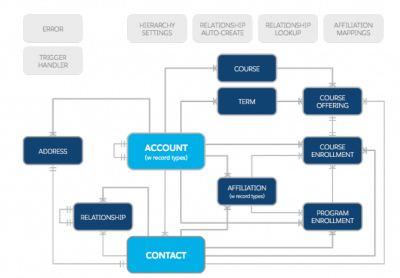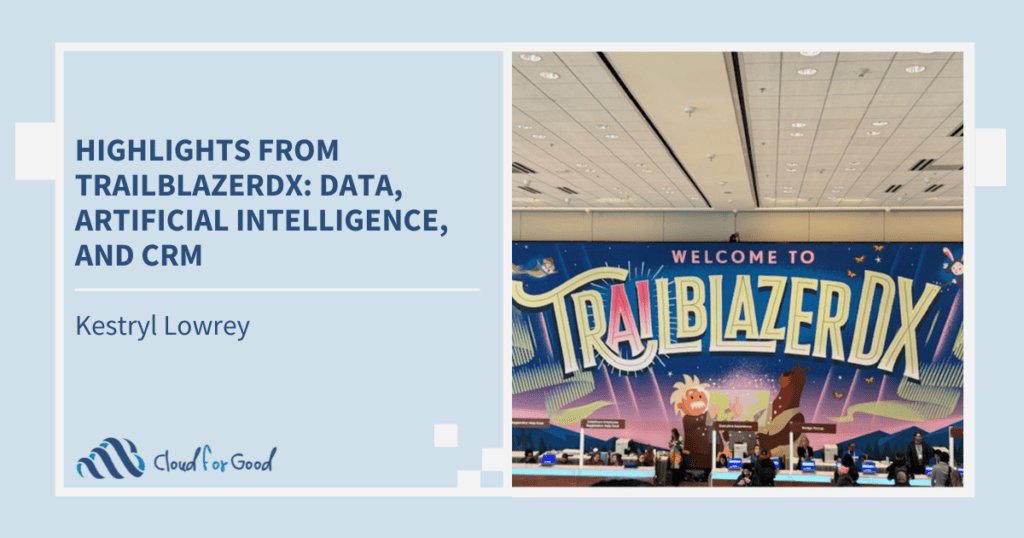Salesforce.org recently released a new tool for colleges and universities, the Higher Education Data Architecture (HEDA) package. HEDA aims to offer a core architecture package for managing common relationship data across the student lifecycle, including institutional and departmental affiliations, interpersonal relationships, and course enrollments. The package is not intended to satisfy all CRM use cases for higher education; instead, it’s an open and flexible framework that can be further customized for each university’s specific needs. This baseline architecture can then provide an accepted integration standard for the vendor ecosystem on the AppExchange that hopes to serve college and universities.
HEDA was developed because there was not an accepted standard for baseline architecture for colleges and universities using Salesforce. Each college or university took their own approach to managing CRM data for students, and sometimes encountered challenges with integrating additional applications to their custom data model. HEDA attempts to address these challenges by offering an architecture that works across enterprise use cases for managing relational student and course data. This community-driven package of data architecture and workflow automation configures Salesforce out-of-the-box to suit higher education use cases for managing student lifecycles.
Similar to the Nonprofit Starter Pack (NPSP), HEDA contains the basic architecture and business logic to support some of the CRM needs of the higher education sector. This base package can then be further customized with your own architecture and/or apps from the AppExchange, to fully suit your university’s needs. HEDA is built to work best on the Lightning Experience, the shiny new set of tools, technologies, and user interfaces on the Salesforce1 platform. You can still use HEDA if you’d prefer to operate in Classic Salesforce, but the experience may be smoother and more intuitive on Lightning.
If you’re already familiar with the NPSP, you may recognize some of HEDA’s functionality: the Administrative Account that HEDA creates for each student is similar to the “One to One” Account Model on NPSP, and the architecture and automation for managing addresses and relationships is comparable to the same functionalities on the NPSP. Affiliation management on HEDA is more advanced, allowing you to track multiple “Primary” account affiliations for a single contact, including Primary Department, Primary Educational Institution, Primary Business Organization, and Primary Sports Organization.
In addition to relationship and affiliation management, HEDA includes architecture for managing courses and enrollments. The package includes custom objects for Courses, Terms, Course Offerings, Course Enrollments, and Program Enrollments. This allows users to track which degree program a student is pursing, the courses they are enrolled in related to their program, and the terms in which they are taking each Course. The Course Enrollment additionally allows for tracking the credits and grade the student received in each Course. All of these objects can be further customized with additional fields or process automation to support your university’s use case, but the basic framework is there to get you started.
HEDA has the makings of a powerful tool for any college or university, but keep in mind that it is intended to be a core data framework for managing the student life cycle, and not a fully functional tool for all higher education use cases. For example, additional customization would need to be added to your HEDA implementation if you also wanted to use it to manage advancement/fundraising, your admissions process, or housing/facilities management. Other use cases, such as a Learning Management System (LMS), may be best suited by integrating another app from the AppExchange. HEDA is designed to be an open and flexible tool, allowing your college or university to use it as base architecture before adding additional custom configuration, development, or app integrations to suit your use cases and requirements.
You may be wondering, “What is the difference between HEDA and Salesforce.org’s other product targeting higher education use cases, Advancement Connect?” A key difference here is that while HEDA offers architecture for managing the student lifecycle, Advancement Connect focuses on advancement efforts with alumni, foundations, and major donors, offering a full tool suite for fundraising, event, and volunteer management. It is not recommended to install HEDA and Advancement Connect into the same Salesforce instance, but it is possible that your university could use both tools in separate instances, leveraging a HEDA-based org to track students through their coursework, and then moving them into Advancement Connect after they graduate.
If you’re curious about HEDA, you can learn more by watching this webinar or visiting the documentation on the Power of Us Hub. If you’re ready to install in your sandbox or a developer org, you can give that a try too. Finally, if you’re interested in implementing HEDA but you need some help, don’t hesitate to get in touch! Our team of consultants is ready to help you implement and customize HEDA to best suit your needs for tracking the full student journey from prospect to alumni.
Related Content:





